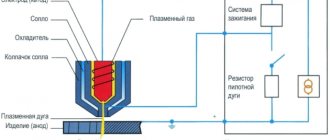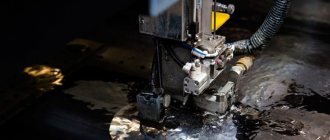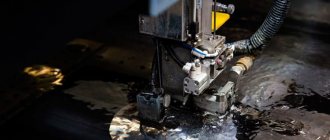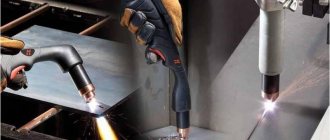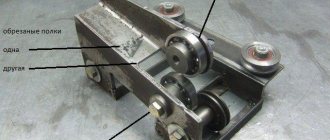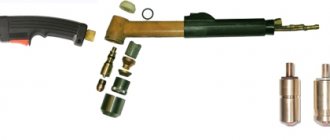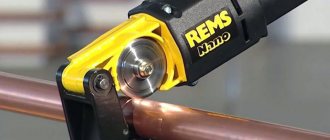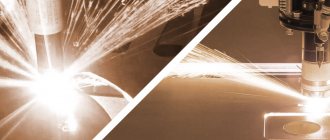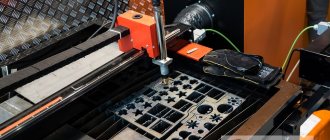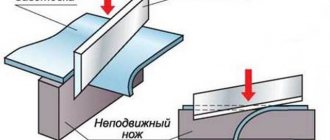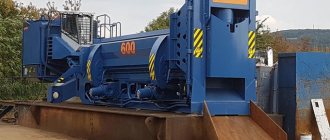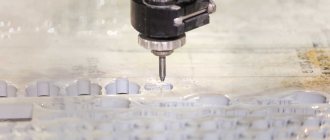Openwork patterns made of metal look fabulous and amaze with the contrast - rough iron and thin lines of a transparent design. With the help of artistic metal cutting, you can make uniquely beautiful gates, decorative furniture, a barbecue or a weather vane. Flat figures made from black sheets are used in decorating courtyards, interiors, and front gardens.
Artistic metal cutting
What is artistic metal cutting
From an aesthetic point of view, artistic cutting is the transformation of a rough sheet of metal into a picture with delicate lines or an original openwork pattern. Technically, a large number of closed contours are cut out, resulting in an image in the contrast of metal and voids.
Metal is cut in various ways using special equipment. Each type of machine has its own characteristics and technical characteristics. The method of decorating a fence and a house with metal carvings is not budgetary, but it is much cheaper than artistic forging and easier to make carved parts yourself. Cutting equipment is generally expensive and bulky. It is impossible to install it in a home workshop.
A special tool mechanically and by heating to high temperatures cuts a thin strip of sheet exactly along a marked or programmed line. The result is figures in a frame or with a free curved outline. Depending on the power of the equipment, sheets up to 10 mm thick can be processed. For artistic cutting, rolled products up to 2 mm thick are used.
The result is a fence element, gate or window grille. In terms of the degree of inaccessibility, the products are not inferior to metal profiles and look more beautiful than those made using artistic forging. There are an unlimited number of design options. You can recreate any two-color picture from a book or the Internet.
Advantages of artistic cutting on a plasma machine
Using this technology, products of the required shapes and sizes are obtained, and at a very affordable price. Plasma cutting machines provide high precision of shaped parts made according to an existing catalog or cut to order, according to individual sketches or drawings.
The advantages of plasma artistic cutting are as follows:
- the resulting elements are not deformed during the cutting process;
- equipment provides greater productivity;
- plasma cutting allows you to minimize metal waste by rationally cutting the sheet and reducing the width of the cut;
- the program will provide minor deviations when cutting out the most complex shaped parts and patterns;
- After receiving the workpieces, there is no need to straighten or clean up their contours.
This technology makes it possible to obtain inexpensive barbecues made using plasma cutting. Plasma equipment makes it possible to quickly and efficiently cut out the parts of the barbecue, both the box and the shaped holes that serve to blow in air, ensuring good combustion of the wood.
Also today, in the wake of patriotism, the Russian coat of arms for plasma cutting has become popular. Owners of such equipment quickly and in the smallest detail cut out the Russian state emblem from metal, satisfying the increased demand among Russians, thereby receiving a decent profit.
Types of artistic metal cutting
There are a large number of types of artistic metal cutting. Melting and mechanical action are mainly used. The most popular processing methods:
- laser cutting;
- plasma cutting;
- water jet treatment;
- mechanical cutting methods;
- flexible;
- calibration
Each type of processing is performed on special equipment or a hand tool is adapted for this purpose.
Plasma cutting
Mechanical metal cutting
Mechanical processing is the most accessible for home production of artistic metal paintings. Various cutting methods are used:
- drilling;
- milling;
- cutting disc;
- on the guillotine;
- disc shears.
A cutting disc is inserted into the grinder and guided along the marking line. After this, the edges are protected and burrs are removed.
Before processing with a milling cutter, holes must be drilled in closed contours. Then, manually or according to the program, if the machine is CNC, cut out the design.
The guillotine can be processed only along the outer contour, creating a convex figure from mountain lines.
Disc shears are installed at an angle of 12⁰. The workpiece is moved manually. You can cut out a complex pattern without small elements. Suitable for home making. The work takes a lot of time.
Waterjet cutting
When sandblasting large workpieces, scale, soil, rust, and even a thin layer of metal are removed from the surface of the part. Waterjet cutting works on the same principle. Sand and water burst out of a narrow nozzle under high pressure. The abrasive material removes a thin strip of steel, the liquid washes out and removes small particles of metal and sand.
Plasma and shaped cutting of materials
Plasma cutting technology is widely used in industry for cutting rolled products up to 100 mm thick. A jet of hot gas is used as a cutting tool. The cutting quality is not affected by coating or surface cleanliness. The cutter follows a given path, the speed depends on the thickness of the sheet and the composition of the material.
When processing a sheet with a thickness of 2 mm, the edges are smooth, without melting. Due to the ability to regulate the power of the plasma jet, CNC machines produce volumetric shaped cutting of metal. The material is not cut through, but a relief specified by the program is created by removing different amounts of metal. As a result, you can get three-dimensional paintings and relief ornaments.
Laser cutting
A thin and powerful laser beam is capable of cutting metal at high speed. The line is narrow and clean at the edges. Laser cutting is performed with constant power. The speed of the tool depends only on the thickness of the metal. The steel burns through quite quickly. The productivity of the equipment, when cutting according to a given program, is high.
You can manually control the movement of the laser head according to a given pattern. The operator must have operating skills. When delayed in one place, the material around the laser beam melts.
Using the laser cutting method, controlling the process using a computer, you can obtain complex designs by entering the sketch into the device program. Lines of any complexity and sharp internal corners are not a problem for the laser.
Artistic bending
Artistic bending refers to cold deformation. It is often used by amateurs to create architectural elements, gates, fences, and window bars.
It is possible to bend metal of various profiles:
- circle;
- square;
- hexagon;
- profile pipe;
- band.
Patterns are used to create design elements that are combined into a specific pattern. Bending is done manually and on rollers.
Grilles on the windows
Air bending and calibration
Both operations can be performed on one device. A V-shaped bottom die and a punch are used for bending. The angle can be from 30⁰.
Calibration is done with a punch that follows the shape of the matrix. The sheet strip after deformation completely repeats the shape of the tool. Regardless of the thickness, the punch presses the strip until it reaches the bottom of the die. The line and bend radius are smooth and clear. A stamp is required for each angle during calibration.
Air bending is done at different angles on one tool. The material does not reach the bottom of the die. The angle to be obtained is adjusted by the stroke of the punch. The deeper the material is immersed in the mold, the sharper the angle.
The bend line is not clear, the radius has a smooth transition into a straight line. It is impossible to repeat several times and create exactly the same bends, even with an automatic, adjusted punch feed. The metal can spring back, causing the angle to change.
Calibration is used in mass production to obtain an accurate shape and alignment of the metal over the entire plane. It is performed as a finishing operation after complex deformation of steel in a cold and hot state. In this case, the material is strengthened over the entire surface.
Working principle of a plasma cutter
A plasma cutter with a computer numerical control (CNC) system is used for high-precision metal processing and manufacturing of parts. Plasma machines are among the equipment capable of performing the most complex tasks, and therefore are indispensable in modern production.
Plasma cutters are used when cutting electrically conductive materials is required. In general, their main purpose involves the production of metal parts, but sometimes plasma cutting devices are used in the production of wood and plastic blanks.
Plasma machines differ from each other in the method of arc ignition and the power of the cooling system.
From the point of view of the method of application, machine tools for plasma cutting are divided into devices that work with:
- protective reducing gases;
- oxidizing, oxygenated gases;
- mixtures;
- gas-liquid stabilizers;
- water and magnetic stabilization.
By type of equipment, machines are divided into:
- inverter;
- transformer
The first group includes budget devices for plasma cutting of metal sheets whose thickness does not exceed 3 cm. This equipment is light in weight and ensures stable arc burning. In terms of efficiency, plasma cutters of this type are superior to their transformer counterparts, but they are only suitable for work in private workshops and small enterprises.
We recommend articles on metalworking
- Steel grades: classification and interpretation
- Aluminum grades and areas of their application
- Defects in metal products: causes and search methods
Transformer devices have a higher price, but they cope with cutting metal workpieces up to 8 cm thick. The energy consumption of such equipment is much higher than that of inverter equipment. But it is characterized by increased reliability, since its signal is resistant to voltage surges in the network.
In addition, machine-tool plasma devices are divided into two categories based on the type of contact. They can be:
- contact;
- contactless.
The operating principle of contact-type CNC plasma cutting machines is that the plasma comes into contact with the metal surface. Such devices are capable of cutting through metal to a depth of no more than 1.8 cm. While systems of the second type can easily produce any product due to the maximum allowable cutting depth.
If a plasma cutter is used for domestic purposes, it requires an electrical network with a voltage of 220 V. Industrial analogues are powered by a three-phase network of 380 V. However, if you are going to use such a device, you need to understand that even household appliances for plasma cutting place a serious load on the electrical wiring. This is due to the fact that not only the plasma cutting machine works, but also the cooling system. Therefore, before starting work, be sure to use special equipment to make sure that you have good electrical wiring that can cope with heavy loads.
Today, plasma cutters are firmly established in the industry; their popularity is associated with such advantages as:
- possibility of automatic cutting in autonomous or semi-autonomous mode;
- high accuracy of work;
- long service life;
- the highest performance among similar devices;
- easy to use.
The control program allows the CNC machine to produce a large number of parts at once according to one drawing for plasma cutting of metal.
Another advantage of this machine is the ability to process even the hardest types of steel. The minimum thickness to which a plasma cutter is immersed in a sheet of metal is 0.5 mm, and the maximum reaches 15 cm. In the process of plasma cutting of metal, an even cut is formed in accordance with the drawing. However, the workpiece practically does not heat up during operation.
When cutting metal with this tool, the likelihood of failures is very low. To prove this, let’s take a closer look at the stages of operation of the plasma cutter. The production process begins with the preparation of drawings. After the required program has been set, the machine receives a signal; it is now ready to start cutting after pressing the power button.
Next, the plasmatron begins to receive current and forms a working arc, whose temperature exceeds +1,000 °C - it is under such conditions that cutting any metals is possible. Pressure is built up, due to which air enters the chamber. Under the influence of high temperature, the air heats up and ionizes, and begins to conduct current.
Entering the nozzle, the air turns into plasma and is supplied to the workpiece. As soon as the plasma and the metal surface come into contact, the arc of the working tool lights up and begins to melt the metal along a predetermined trajectory. This is how plasma cutting of metal is carried out according to drawings.
Advantages and disadvantages
Art cutting is widely used to create beautiful and durable items to decorate your home and yard. It has its advantages and disadvantages. The technology of figured processing is used to decorate:
- fences;
- gates and gates;
- bars on windows;
- fireplace enclosures;
- railing posts;
- weather vane;
- decorative elements of facades;
- furniture.
Metal decor combines the brutality of black metal and the delicacy of openwork. The fences are strong and allow light to pass through.
The sheet is treated with cold point treatment. This ensures no deformation. The web remains flat unless bending is performed.
The disadvantages include the high cost of work and equipment, and high energy consumption. You cannot install a plasma cutting machine in a small workshop. They don’t buy it for the sake of a beautiful fence or window decoration.
Artistic plasma. cutting How to prepare a drawing for CNC? My way
I launched my Chinese console machine, which I described in another topic.
Now I'm faced with the problem of preparing drawings for artistic cutting.
If with ordinary drawings everything is simple for me, I draw in Compass, in ProNest I lay out the parts on the sheet and in the same place the UE.
But with artistic cutting there are the following problems:
1. In Compass it is inconvenient to draw, for example, a beautiful carved gate; it is much more convenient to outline a raster in Korel.
2. After it’s drawn in Corel, we save it in DXF and here’s the problem, the entire drawing consists of NURBS lines (at least that’s how Compass sees them), but ProNest hangs tightly from Core drawings. Experiencedly I found out that the problem is in NURBS lines, and the question arises of how to turn them into ordinary Arcs, contours, segments...
……2.1 The first method is quite hectic - put the DXF into Solid and then save it again into DXF. But when importing into Solid, some connections are broken, but fortunately in Solid there is an option to check for jambs and within 15 minutes you can connect everything that was broken
……2.2 The second method is simpler, but the geometry is violated, this is to immediately save the DXF version R11 from Corel, but then the entire drawing will consist of segments, i.e. not a single arc, all circles will turn into polyhedra and the UE code turns out to be lengthy
……2.3 The third method is the most ideal. If I’m not mistaken, Ukrainian craftsmen wrote the EPS-OUT application, it’s not easy to find, there’s not enough information, so I’ll attach it below + video. But the main problem is that it only works on Windows XP, this problem was easily solved - we install a virtual machine with Windows XP and there is no problem. From Corel we save it in EPS, run it with the program in a couple of clicks and that’s it. All Korelov’s NURBS are divided into arcs, segments, contours just perfectly, no modifications, I tried so many complex drawings, everything can be put into the machine right away, it cuts perfectly, ProNest draws all the inputs and outputs in seconds.
3. I also tried SheetCam, it understands NURBS curves, but it generally doesn’t care about all the mistakes in the drawing, there is a gap in the lines - be kind enough to find it yourself, otherwise it will mess up in the UE. Well, I don’t like this Shitkam, so maybe those who work for him will let you know if everything is going well with him with cutting complex large drawings.
4. Perhaps in new versions of ProNest there is already work with NURBS, but in version 12 it does not work, and I have not seen others on torrents.
So my way of working:
1. Draw in Corel (I especially like auto-raster tracing)
2. Select all the points and reduce them to the maximum (just make sure that the picture does not lose quality)
3. Save as DXF
4. We put it into SolidWorks to check for errors (a cool function, it looks for mistakes in a vector drawing, erroneous points, breaks. If there are any, we fix them right away in Corel, maybe Corel has such a function too, I haven’t looked for it yet)
5. Once the drawing has been perfected, save it in EPS
6. We run it through EPS-OUT, we get excellent DXF without any NURBS.
7. At ProNeste we do UE.
8. We cut.
This is what it looks like in Corel:
This is what Korelovsky DXF, not processed by the program, looks like, as you can see, it consists of these NURBS (Bézier curves, they are easy to edit, drag, change the bend, but because of them many of the described problems arise when cutting)
And this is what the file processed by the EPS-OUT program already looks like, as you can see there are already 4 arcs connected to each other, the shape of the bend cannot be smoothly changed, but it is no longer necessary for the machine:
How do you prepare drawings for artistic cutting?
Here you can download the program, a video of how it works, and the Theory of the authors of the program creators:
https://yadi.sk/d/NR1jZg8O3ALgCR
If anyone knows good exchangers, please re-upload, otherwise what happens to my Yandex disk, I’ll forget, delete the file...
Well, as a bonus, I’ll upload the source code of the beautiful gates that freelancers drew for me, because of which all this pandemonium began:
https://yadi.sk/d/fNs-H2v73ALqin
This is a file that I have not corrected yet, there are quite a few jambs in it, about 7 pieces. artifacts (small invisible extra details, visible at high magnification), consists of NURBS entirely, there is, in my opinion, one open circuit (at least Solid sees it that way, or maybe he opens it himself).
Please experiment with those who work on ProNeste, especially later than version 12, will it load? won't it mess up? Well, you can also try it in your own way and tell us about your success.
And with this drawing, half an hour of work and you can cut a gorgeous gate.
Equipment for artistic cutting
Mechanical cutting is suitable for making carved paintings on metal yourself. High-performance artistic cutting equipment uses a plasma arc and laser. Such machines have a narrow specialization. They occupy a large area and operate at industrial voltage.
CNC milling and turning machines are used for artistic processing of metal, wood and plastic. Using given programs, they can cut out an end-to-end pattern and make a three-dimensional image.
Welding machines are used to create patterns with large elements without sharp corners.
Sketches for plasma cutting
Below are options for plasma cutting designs in .dxf format, which can be downloaded for free. This is a basic catalog that you can significantly expand over time, offering your customers more and more new designs, patterns, ornaments and decorative elements made of metal.
The presented sketches for plasma cutting are taken from this source.
If you are interested in purchasing an inexpensive but reliable machine for artistic metal cutting, call us at any time. Our managers will select the right model for you. Within 1-2 days, we will train your plasma cutting machine operator to operate such equipment. A profitable business is not difficult. And for your business to go uphill, give us just one call - we will help you increase your income.
How to make an inscription on metal with your own hands
To make an inscription at home or cut out a weather vane figure or a fireplace grate, mechanical artistic metal cutting is used. Disc scissors allow you to create simple designs. You just need to practice and accurately guide the sheet to the cut area along a given line.
Craftsmen use a router with a copy sleeve to create inscriptions on metal, especially soft aluminum and bronze. First, a template is made from plywood or other material. Its lines are shifted in each direction by the difference in the diameters of the cutter and ring. Then the copier is applied to the material and processed with a milling cutter.
